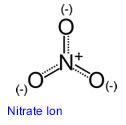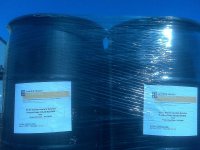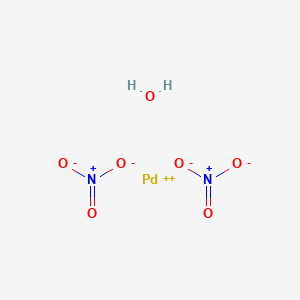SECTION 1. IDENTIFICATION
Product Name: Palladium(II) Nitrate Solution
Product Number: All applicable American Elements product codes, e.g. PD-NAT-02-SOL
, PD-NAT-03-SOL
, PD-NAT-04-SOL
, PD-NAT-05-SOL
CAS #: 10102-05-3
Relevant identified uses of the substance: Scientific research and development
Supplier details:
American Elements
10884 Weyburn Ave.
Los Angeles, CA 90024
Tel: +1 310-208-0551
Fax: +1 310-208-0351
Emergency telephone number:
Domestic, North America: +1 800-424-9300
International: +1 703-527-3887
SECTION 2. HAZARDS IDENTIFICATION
Classification of the substance or mixture in accordance with 29 CFR 1910 (OSHA HCS)
GHS05 Corrosion
Met. Corr.1 H290 May be corrosive to metals.
Skin Corr. 1B H314 Causes severe skin burns and eye damage.
Eye Dam. 1 H318 Causes serious eye damage.
GHS07
Acute Tox. 4 H302 Harmful if swallowed.
Skin Sens. 1 H317 May cause an allergic skin reaction.
Hazards not otherwise classified No data available.
GHS label elements The product is classified and labeled in accordance with 29 CFR 1910 (OSHA HCS)
Hazard pictograms


GHS05 GHS07
Signal word Danger
Hazard-determining components of labeling:
Nitric acid
Palladium(II) nitrate hydrate
Hazard statements
H290 May be corrosive to metals.
H302 Harmful if swallowed.
H314 Causes severe skin burns and eye damage.
H317 May cause an allergic skin reaction.
Precautionary statements
P260 Do not breathe dust/fume/gas/mist/vapors/spray.
P303+P361+P353 If on skin (or hair): Take off immediately all contaminated clothing. Rinse skin with water/shower.
P305+P351+P338 IF IN EYES: Rinse cautiously with water for several minutes. Remove contact lenses, if present and easy to do. Continue rinsing.
P301+P330+P331 IF SWALLOWED: rinse mouth. Do NOT induce vomiting.
P405 Store locked up.
P501 Dispose of contents/container in accordance with local/regional/national/international regulations.
WHMIS classification
D2B - Toxic material causing other toxic effects
E - Corrosive material
Classification system
HMIS ratings (scale 0-4)
(Hazardous Materials Identification System)
HEALTH
FIRE
REACTIVITY
3
0
1
Health (acute effects) = 3
Flammability = 0
Physical Hazard = 1
Other hazards
Results of PBT and vPvB assessment:
PBT: N/A.
vPvB: N/A.
SECTION 3. COMPOSITION/INFORMATION ON INGREDIENTS
Chemical characterization: Mixtures
Dangerous components:
10102-05-3 Palladium(II) nitrate hydrate Ox. Sol. 2, H272; Skin Irrit. 2, H315; Eye Irrit. 2A, H319; Skin Sens. 1, H317 21.0%
7697-37-2 Nitric acid Ox. Liq. 3, H272; Skin Corr. 1A, H314 15.0%
Non-Hazardous Ingredients
7732-18-5 Water 64.0%
SECTION 4. FIRST AID MEASURES
Description of first aid measures
General information Immediately remove any clothing soiled by the product.
If inhaled:
Supply fresh air. If not breathing, provide artificial respiration. Keep patient warm.
Seek immediate medical advice.
In case of skin contact:
Immediately wash with soap and water; rinse thoroughly.
Seek immediate medical advice.
In case of eye contact: Rinse opened eye for several minutes under running water. Consult a physician.
If swallowed: Seek medical treatment.
Information for doctor
Most important symptoms and effects, both acute and delayed
Causes severe skin burns.
Causes serious eye damage.
Indication of any immediate medical attention and special treatment needed No information available.
SECTION 5. FIREFIGHTING MEASURES
Extinguishing media
Suitable extinguishing media Product is not flammable. Use fire-fighting measures that suit the surrounding fire.
Special hazards arising from the substance or mixture
If this product is involved in a fire, the following can be released:
Nitrogen oxides (NOx)
Palladium oxide
Advice for firefighters
Protective equipment:
Wear self-contained respirator.
Wear fully protective impervious suit.
SECTION 6. ACCIDENTAL RELEASE MEASURES
Personal precautions, protective equipment and emergency procedures
Wear protective equipment. Keep unprotected persons away.
Ensure adequate ventilation
Environmental precautions: Do not allow material to be released to the environment without official permits.
Methods and material for containment and cleanup:
Absorb with liquid-binding material (sand, diatomite, acid binders, universal binders, sawdust).
Use neutralizing agent.
Dispose of contaminated material as waste according to section 13.
Ensure adequate ventilation.
Prevention of secondary hazards: No special measures required.
Reference to other sections
See Section 7 for information on safe handling
See Section 8 for information on personal protection equipment.
See Section 13 for disposal information.
SECTION 7. HANDLING AND STORAGE
Handling
Precautions for safe handling
Keep container tightly sealed.
Store in cool, dry place in tightly closed containers.
Ensure adequate ventilation.
Information about protection against explosions and fires: The product is not flammable
Conditions for safe storage, including any incompatibilities
Storage
Requirements to be met by storerooms and receptacles: No special requirements.
Information about storage in one common storage facility:
Store away from strong bases.
Store away from metals.
Further information about storage conditions:
Keep container tightly sealed.
Store in cool, dry conditions in well-sealed containers.
Specific end use(s) No information available.
SECTION 8. EXPOSURE CONTROLS/PERSONAL PROTECTION
Additional information about design of technical systems:
Properly operating chemical fume hood designed for hazardous chemicals and having an average face velocity of at least 100 feet per minute.
Control parameters
Components with limit values that require monitoring at the workplace:
7697-37-2 Nitric acid (15.0%)
PEL (USA) Long-term value: 5 mg/m³, 2 ppm
REL (USA) Short-term value: 10 mg/m³, 4 ppm
Long-term value: 5 mg/m³, 2 ppm
TLV (USA) Short-term value: 10 mg/m³, 4 ppm
Long-term value: 5.2 mg/m³, 2 ppm
EL (Canada) Short-term value: 4 ppm
Long-term value: 2 ppm
EV (Canada) Short-term value: 10 mg/m³, 4 ppm
Long-term value: 5 mg/m³, 2 ppm
Additional information: No data
Exposure controls
Personal protective equipment
Follow typical general protective and industrial hygiene measures for handling chemicals.
Keep away from foodstuffs, beverages and feed.
Remove all soiled and contaminated clothing immediately.
Wash hands before breaks and at the end of work.
Do not inhale dust / smoke / mist.
Avoid contact with the eyes and skin.
Breathing equipment: Use suitable respirator when high concentrations are present.
Recommended filter device for short term use:
Use a respirator with multi-purpose combination (US) or type ABEK (EN 14387) as a backup to engineering controls. Risk assessment should be performed to
determine if air-purifying respirators are appropriate. Only use equipment tested and approved under appropriate government standards such as NIOSH (USA) or
CEN (EU).
Protection of hands:
Impervious gloves
Inspect gloves prior to use.
The selection of suitable gloves not only depends on the material, but also on quality. Quality will vary from manufacturer to manufacturer.
Material of gloves Nitrile rubber, NBR
Penetration time of glove material (in minutes) 480
Glove thickness 0.11 mm
Eye protection:
Tightly sealed goggles
Full face protection
Body protection: Protective work clothing.
SECTION 9. PHYSICAL AND CHEMICAL PROPERTIES
Information on basic physical and chemical properties
Appearance:
Form: Liquid
Color: Brown to yellow to orange
Odor: No data available.
Odor threshold: No data available.
pH: No data available.
Melting point/range: No data available.
Boiling point/range: No data available.
Sublimation temperature / start: No data available.
Flammability (solid, gas): No data available.
Ignition temperature: No data available.
Decomposition temperature: No data available.
Auto igniting: Product is not selfigniting.
Danger of explosion: No data available.
Explosion limits:
Lower: No data available.
Upper: No data available.
Vapor pressure at 20 °C (68 °F): 4 hPa (3 mm Hg)
Density: No data available.
Relative density No data available.
Vapor density No data available.
Evaporation rate No data available.
Solubility in / Miscibility with
Water: Fully miscible
Partition coefficient (n-octanol/water): No data available.
Viscosity:
Dynamic: No data available.
Kinematic: No data available.
Solvent content:
Organic solvents: 0.0 %
Solids content: 12.3 %
Other information No information available.
SECTION 10. STABILITY AND REACTIVITY
Reactivity No data available.
Chemical stability Stable under recommended storage conditions.
Thermal decomposition / conditions to be avoided: Decomposition will not occur if used and stored according to specifications.
Possibility of hazardous reactions No dangerous reactions known
Conditions to avoid No information available.
Incompatible materials:
Flammable substances
Reducing agents
Bases
Metals
Hazardous decomposition products:
Nitrogen oxides
Palladium oxide
SECTION 11. TOXICOLOGICAL INFORMATION
Information on toxicological effects
Acute toxicity:
Harmful if swallowed.
Swallowing will lead to a strong corrosive effect on mouth and throat and to the danger of perforation of esophagus and stomach.
The Registry of Toxic Effects of Chemical Substances (RTECS) contains acute toxicity data for components in this product.
LD/LC50 values that are relevant for classification:
7697-37-2 Nitric acid
Inhalative LC50/4H 0.13 mg/l/4H (rat)
Skin irritation or corrosion: Causes severe skin burns.
Eye irritation or corrosion: Causes serious eye damage.
Sensitization: May cause an allergic skin reaction.
Germ cell mutagenicity: The Registry of Toxic Effects of Chemical Substances (RTECS) contains mutation data for components in this product.
Carcinogenicity: No classification data on carcinogenic properties of this material is available from the EPA, IARC, NTP, OSHA or ACGIH.
Reproductive toxicity: The Registry of Toxic Effects of Chemical Substances (RTECS) contains reproductive data for components in this product.
Specific target organ system toxicity - repeated exposure: N/A
Specific target organ system toxicity - single exposure: N/A
Aspiration hazard: N/A
Subacute to chronic toxicity: The Registry of Toxic Effects of Chemical Substances (RTECS) contains multiple dose toxicity data for this substance.
Additional toxicological information:
To the best of our knowledge the acute and chronic toxicity of this substance is not fully known.
The product shows the following dangers according to internally approved calculation methods for preparations:
Harmful
Corrosive
Irritant
SECTION 12. ECOLOGICAL INFORMATION
Toxicity
Aquatic toxicity: No information available.
Persistence and degradability: No information available.
Bioaccumulative potential: No information available.
Mobility in soil: No information available.
Additional ecological information:
General notes:
Do not allow product to reach ground water, water course or sewage system.
Do not allow material to be released to the environment without official permits.
Danger to drinking water if even small quantities leak into the ground.
Also poisonous for fish and plankton in water bodies.
Toxic to aquatic life.
May cause long lasting harmful effects to aquatic life.
Avoid transfer into the environment.
Results of PBT and vPvB assessment:
PBT: N/A.
vPvB: N/A.
Other adverse effects No information available.
SECTION 13. DISPOSAL CONSIDERATIONS
Waste treatment methods
Recommendation: Consult state, local or national regulations to ensure proper disposal.
Uncleaned packagings:
Recommendation: Disposal must be made according to official regulations.
Recommended cleansing agent: Water, if necessary with cleansing agents.
SECTION 14. TRANSPORT INFORMATION
UN-Number
DOT, IMDG, IATA UN3264
UN proper shipping name
DOT Corrosive liquid, acidic, inorganic, n.o.s. (Nitric acid)
IMDG CORROSIVE LIQUID, ACIDIC, INORGANIC, N.O.S. (NITRIC ACID), MARINE
POLLUTANT
IATA CORROSIVE LIQUID, ACIDIC, INORGANIC, N.O.S. (NITRIC ACID)
Transport hazard class(es)
DOT
Class 8 Corrosive substances.
Label 8
Class 8 (C1) Corrosive substances
Label 8
IMDG
Class 8 Corrosive substances.
Label 8
IATA
Class 8 Corrosive substances.
Label 8
Packing group
DOT, IMDG, IATA III
Environmental hazards:
Marine pollutant (IMDG): Symbol (fish and tree)
Special precautions for user Warning: Corrosive substances
EMS Number: F-A,S-B
Segregation groups Acids
Transport in bulk according to Annex II of MARPOL73/78 and the IBC Code N/A.
Transport/Additional information:
DOT
Marine Pollutant (DOT): No
Remarks: Special marking with the symbol (fish and tree).
UN "Model Regulation": UN3264, Corrosive liquid, acidic, inorganic, n.o.s. (Nitric acid), 8, II
SECTION 15. REGULATORY INFORMATION
Safety, health and environmental regulations/legislation specific for the substance or mixture
GHS label elements The product is classified and labeled in accordance with 29 CFR 1910 (OSHA HCS)
Hazard pictograms
GHS05 GHS07
Signal word Danger
Hazard-determining components of labeling:
Nitric acid
Palladium(II) nitrate hydrate
Hazard statements
H290 May be corrosive to metals.
H302 Harmful if swallowed.
H314 Causes severe skin burns and eye damage.
H317 May cause an allergic skin reaction.
Precautionary statements
P260 Do not breathe dust/fume/gas/mist/vapors/spray.
P303+P361+P353 If on skin (or hair): Take off immediately all contaminated clothing. Rinse skin with water/shower.
P305+P351+P338 IF IN EYES: Rinse cautiously with water for several minutes. Remove contact lenses, if present and easy to do. Continue rinsing.
P301+P330+P331 IF SWALLOWED: rinse mouth. Do NOT induce vomiting.
P405 Store locked up.
P501 Dispose of contents/container in accordance with local/regional/national/international regulations.
National regulations
All components of this product are listed in the U.S. Environmental Protection Agency Toxic Substances Control Act Chemical substance Inventory.
All components of this product are listed on the Canadian Domestic Substances List (DSL).
SARA Section 313 (specific toxic chemical listings)
7697-37-2 Nitric acid 15.0%
California Proposition 65
Prop 65 - Chemicals known to cause cancer
None of the ingredients are listed.
Prop 65 - Developmental toxicity
None of the ingredients are listed.
Prop 65 - Developmental toxicity, female
None of the ingredients are listed.
Prop 65 - Developmental toxicity, male
None of the ingredients are listed.
Information about limitation of use: For use only by technically qualified individuals.
Other regulations, limitations and prohibitive regulations
Substance of Very High Concern (SVHC) according to the REACH Regulations (EC) No. 1907/2006.
None of the ingredients are listed.
The conditions of restrictions according to Article 67 and Annex XVII of the Regulation (EC) No 1907/2006 (REACH) for the manufacturing, placing on the
market and use must be observed.
None of the ingredients is listed.
Annex XIV of the REACH Regulations (requiring Authorisation for use)
None of the ingredients is listed.
Chemical safety assessment: A Chemical Safety Assessment has not been carried out.
SECTION 16. OTHER INFORMATION
Safety Data Sheet according to Regulation (EC) No. 1907/2006 (REACH). The above information is believed to be correct but does not purport to be all inclusive and shall be used only as a guide. The information in this document is based on the present state of our knowledge and is applicable to the product with regard to appropriate safety precautions. It does not represent any guarantee of the properties of the product. American Elements shall not be held liable for any damage resulting from handling or from contact with the above product. See reverse side of invoice or packing slip for additional terms and conditions of sale. COPYRIGHT 1997-2022 AMERICAN ELEMENTS. LICENSED GRANTED TO MAKE UNLIMITED PAPER COPIES FOR INTERNAL USE ONLY.

 materials. American Elements can prepare dissolved homogeneous solutions at customer specified concentrations or to the maximum stoichiometric concentration. Packaging is available in 55 gallon drums, smaller units and larger liquid totes. American Elements maintains
materials. American Elements can prepare dissolved homogeneous solutions at customer specified concentrations or to the maximum stoichiometric concentration. Packaging is available in 55 gallon drums, smaller units and larger liquid totes. American Elements maintains  See more Palladium products.
See more Palladium products. Palladium has the lowest melting point and is the least dense of the group. Palladium can be found as a free metal and alloyed with other platinum-group metals.
Palladium has the lowest melting point and is the least dense of the group. Palladium can be found as a free metal and alloyed with other platinum-group metals. 
